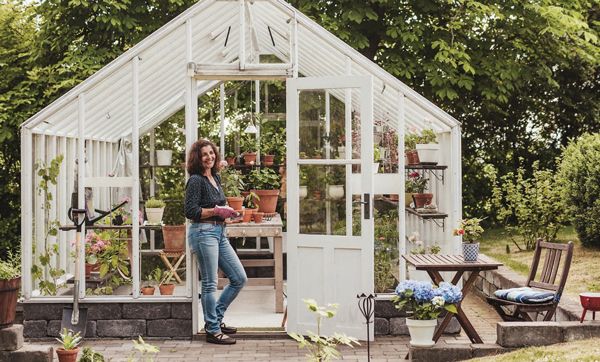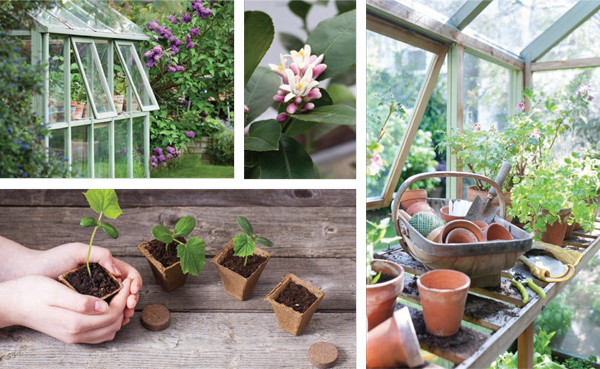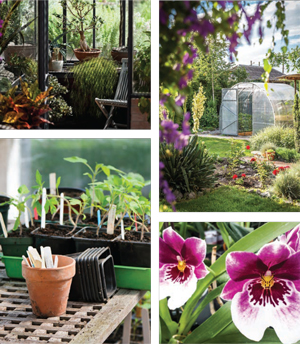Greenhouse Envy | Year-Round Havens for Green-Thumbed Enthusiasts

While crisp mornings in stocking feet with hot chocolate on the stovetop, and a fire roaring nearby can make just about anyone feel content, you may still long for the lush greenery and fresh vegetables of summertime that are a distant memory this time of year. Perhaps you are a gardener looking to make your hobby more of a priority. Or maybe stress is creeping into daily life, and you need an inviting place to escape and decompress. A home greenhouse could be the answer if you feel creative and need a new project this season. With a variety of sizes and designs for gardeners and craftspersons at all levels, creating a haven for your plants and flowers is easier than you think.
The evolution of greenhouses
History shows us that the idea of creating a greenhouse was conceptualized by Roman emperors who wanted to grow vegetables year-round for health, not unlike many of us today. The first modern greenhouses were botanical gardens built in Italy to display plants and flowers never seen before, brought home by explorers from far-off lands. Holland and England were quick to follow, with the English creating conservatories—more refined spaces not just for growing plants, but for enjoying them. Eventually, specialty greenhouses were adapted for certain fruits— specifically oranges (orangeries) and pineapples (pineries).
While these early conservatories were expensive to build and geared towards the aristocracy, they spawned an interest in botany—the scientific study of plants. The first practical botanical greenhouse was built in Holland in 1599, where plants were studied and grown for medicinal purposes. Eventually, building materials became less expensive and by the mid-1800s, massproduction of greenhouses began. Today, many cities across the country maintain historical botanical gardens and greenhouses, including Wye Orangery, the oldest greenhouse in America, built in 1785 on Maryland’s eastern shore.

Personal greenhouse perks
Building a greenhouse on your property can serve many purposes. The unpredictability of the seasons can bring early frost or late snowfall. Adding a greenhouse allows an early start to the growing season, and an extension of that season well into fall. A greenhouse creates an optimal environment for young plants and seedlings. Starting these youngsters inside gives them a better chance to thrive before hardening off; choose seedlings and plants that will thrive in your area if you plan to move them outdoors. The advantages of greenhouses for year-round gardeners are numerous—the chance to grow plants not native to local gardening zones, and protection from direct sunlight, wind and drought. Inside, plants are pampered with filtered sunlight, plenty of moisture and no wind. Critters and pest control are a thing of the past and garden tools can be stored inside. We all know from science and personal experience that spending time immersed in nature is beneficial to overall health and well-being. A greenhouse can be a sanctuary as well—a calm and relaxing place to enjoy all that nature has to offer.
 From simple to substantial—a variety of sizes
From simple to substantial—a variety of sizes
Greenhouses come in a variety of shapes and sizes to enhance the look and feel of your house and yard. Most compact is a windowmounted greenhouse, built into a south-facing frame. This tiny setup provides an easy introduction to greenhouse gardening and allows for plants and herbs to be grown within reach. If you are ready for something more substantial, consider a leanto greenhouse, built right up against a house or other structure. Since this type of greenhouse only has three sides, it should be placed on the side of the house that gets the most sunlight. The proximity to your home allows for easy maintenance and access to plants, herbs and vegetables, and makes water and electricity from the home convenient and more affordable than in a stand-alone structure.
The serious gardener can make a statement with a free-standing greenhouse, adding beauty to the garden and a year-round retreat for the enthusiast. Freestanding greenhouses can be larger and have more architectural interest than lean-to structures, with roof lines that may be peaked, curved, flat or gabled to complement your existing house. Careful consideration should be taken when choosing a spot for a free-standing greenhouse, as exposure to sunlight and adequate drainage are both crucial to its success. Plan for its future; what may seem like a good size now may be too small once your plants begin to grow.
To build or to buy?
Whether you build from scratch or purchase a kit, the materials you choose are paramount to the longevity of the greenhouse and the plants inside. Glazing is the material that lets sunlight into your greenhouse; glass is a classic choice for glazing but can be cost-prohibitive. A better choice is polycarbonate, a thick plastic recommended by experts more than glass because of its strength, cost and ability to retain heat. The most common types of framing are aluminum, galvanized steel and wood. Choose a frame that will be strong enough to support the glazing material and withstand area weather conditions. Any of these materials are strong and reliable choices; once you decide on your materials, there are numerous local professionals and web-based resources for designing and planning your garden oasis. For a simpler approach, a variety of kits is available for purchase, with materials included.
Whichever path you choose, the result will be a welcome retreat for refining your gardening skills, relishing the beauty of nature and enjoying the fruits of your labor. ✦
Aluminum, botanical gardens, botanical greenhouse, Freestanding greenhouses, galvanized steel, garden, glazing, Greenhouse, leanto greenhouse, optimal environment, Personal greenhouse, specialty greenhouses, vegetables year-round, windowmounted greenhouse, Wood, year-round gardeners






